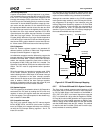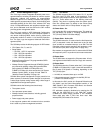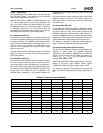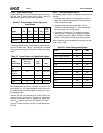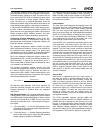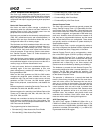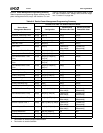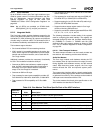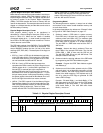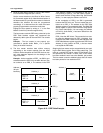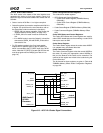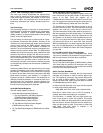
172 AMD Geode™ SC2200 Processor Data Book
Core Logic Module
32580B
6.2.10.3 Peripheral Power Management
The Core Logic module provides peripheral power man-
agement using a combination of device idle timers, address
traps, and general purpose I/O pins. Idle timers are used in
conjunction with traps to support powering down peripheral
devices.
Device Idle Timers and Traps
Idle timers are used to power manage a peripheral by
determining when the peripheral has been inactive for a
specified period of time, and removing power from the
peripheral at the end of that time period.
Idle timers are provided for the commonly-used peripherals
(FDC, IDE, parallel/serial ports, and mouse/keyboard). In
addition, there are three user-defined timers that can be
configured for either I/O or memory ranges.
The idle timers are 16-bit countdown timers with a one sec-
ond timebase or prescaler, providing a timeout range of 1
to 65536 seconds (1092 minutes) (18 hours). The input
clock is 32 KHz. Very small count values have some error
since the prescaler is free-running. (See the next subsec-
tion "General Purpose Timers" for further discussion on
prescaler value limitations.)
When the idle timer count registers are loaded with a non-
zero value and enabled, the timers decrement until one of
two possibilities happens: a bus cycle occurs at that I/O or
memory range, or the timer decrements to zero.
If a bus cycle occurs, the timer is reloaded and begins dec-
rementing again. If the timer decrements to zero, and
power management is enabled (F0 Index 80h[0] = 1), the
timer generates an SMI.
When an idle timer generates an SMI, the SMI handler
manages the peripheral power, disables the timer, and
enables the trap. The next time an event occurs, the trap
generates an SMI. This time, the SMI handler applies
power to the peripheral, resets the timer, and disables the
trap.
Relevant registers for controlling Device Idle Timers are: F0
Index 80h, 81h, 82h, 93h, 98h-9Eh, and ACh.
Relevant registers for controlling User Defined Device Idle
Timers are: F0 Index 81h, 82h, A0h, A2h, A4h, C0h, C4h,
C8h, CCh, CDh, and CEh.
Although not considered as device idle timers, two addi-
tional timers are provided by the Core Logic module. The
Video Idle Timer used for Suspend-determination and the
VGA Timer used for SoftVGA.
The programming bits for these timers are:
• F0 Index 81h[7], Video Access Idle Timer Enable
• F0 Index 82h[7], Video Access Trap Enable
• F0 Index A6h[15:0], Video Timer Count
• F0 Index 83h[3], VGA Timer Enable
• F0 Index 8Bh[6], VGA Timer Base
• F0 Index 8Eh[7:0], VGA Timer Count
General Purpose Timers
The Core Logic module contains two general purpose idle
timers, General Purpose Timer 1 (F0 Index 88h) and Gen-
eral Purpose Timer 2 (F0 Index 8Ah). These two timers are
similar to the Device Idle Timers in that they count down to
zero unless re-triggered, and generate an SMI when they
reach zero. However, these are 8-bit timers instead of 16
bits, they have a programmable timebase, and the events
which reload these timers are configurable. These timers
are typically used for an indication of system inactivity for
Suspend determination.
General Purpose Timer 1 can be re-triggered by activity to
any of the configured User Defined Devices, Keyboard and
Mouse, Parallel and Serial, Floppy disk, or Hard disk.
General Purpose Timer 2 can be re-triggered by a transi-
tion on the GPIO7 signal (if GPIO7 is properly configured).
When a General Purpose Timer is enabled or when an
event reloads the timer, the timer is loaded with the config-
ured count value. Upon expiration of the timer an SMI is
generated and a status flag is set. Once expired, this
counter must be re-initialized by disabling and enabling it.
The timebase or prescaler for both General Purpose Tim-
ers can be configured as either 1 second (default) or 1 mil-
lisecond. The 32 KHz clock feeds the prescaler. The
registers at F0 Index 89h and 8Bh are the control registers
for the General Purpose Timers.
The prescaler (1 millisecond or 1 second) that feeds the
timers is free-running; meaning that the first count decre-
ment will not be correct. The decrement time can be as
short as 0 or as long as the prescaler. The actual time for
the decrement to occur can not be determined since the
current prescaler value can not be read. A periodic timer
can be achieved after the first timer SMI, because when
retriggered, the prescaler will be at or very nearly at the
maximum value. Any software using these timers must
understand this limitation. Small count values have the
most error with a value of 1having the largest error.
ACPI Timer Register
The ACPI Timer register (F1BAR0+I/O Offset 1Ch or at
F1BAR1+I/O Offset 1Ch) provides the ACPI counter. The
counter counts at 14.31818/4 MHz (3.579545 MHz). If SMI
generation is enabled (F0 Index 83h[5] = 1), an SMI or SCI
is generated when bit 23 toggles.



